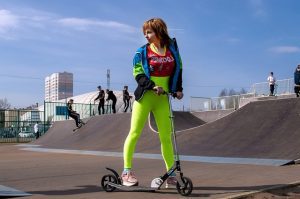We’ve all seen people zipping around on scooters, but have you ever stopped to consider the health benefits of this fun form of transportation? Scooter riding is not just a convenient and eco-friendly way to get around; it’s also an effective workout that can help tone your muscles.
In fact, the act of pushing off the ground, maintaining balance, and steering works for various muscle groups in your body – some of which you may not even realize! Beyond muscle toning, scooter riding can also contribute to cardiovascular fitness. However, like any physical activity, it’s crucial to consider safety measures when riding non-gas-powered scooters.

At FamilyHype, we want to explore scooter riding for fitness: how it tones muscles, contributes to heart health, and what safety precautions are necessary. We’ll even share tips on how to maximize these muscular advantages. So let’s hop on our scooters and ride towards a healthier lifestyle!
Using a scooter to build muscle is a great way to stay in shape and get a full-body workout. It tones your legs, arms, core, and back as you push off the ground, maintain balance, and steer. Additionally, it can help to improve your cardiovascular fitness. However, it is important to consider safety, such as wearing a helmet and other protective gear and ensuring your scooter is in good condition.
Whether you want to tone your muscles, improve your cardiovascular fitness, or have fun, scooter riding can be a great way to get active. So why not grab a scooter and get out there?
Please share with us your experience, and let’s ride towards a healthier lifestyle!
Key Takeaways
Scooter riding can be a great way to tone our muscles and improve cardiovascular health while having fun! It offers numerous overall health and fitness advantages and is a great activity for family and friends. Different muscle groups are engaged while riding a scooter, and the advantages of this workout-on-wheels can be maximized with the right approach.
In physical fitness, scooter-riding can be classified as an aerobic exercise, providing strength training, cardio, and balance training. This exercise is a great way to build muscle and tone your body, as it works your core and lower body muscles like the glutes, hamstrings, quads, and calves. Additionally, scooter riding increases endurance and coordination while burning calories and toning the arms, shoulders, chest, and abdomen.

Scooter riding is an effective way to build and maintain muscle mass and can also help to improve balance and coordination. With its low-impact, high-intensity workout, scooter riding is ideal for people of all ages and fitness levels. Don’t forget to stay safe while enjoying this ride!
With the right approach and a commitment to safety, scooter riding can be a great way to keep yourself toned, fit, and healthy. FamilyHype would love to hear your feedback and experiences, so get out there and enjoy the ride!
The Basics Of Scooter Riding
Scooter riding is a fun and engaging activity that offers numerous benefits. It engages various muscle groups, including the core, legs, and upper body, providing a comprehensive workout.
Scooter riding improves balance, coordination, and cardiovascular fitness, making it an excellent option for staying active and enjoying the outdoors.
Whether a beginner or an experienced rider, scooter riding offers a low-impact way to strengthen muscles, enhance overall fitness, and have a great time. So, hop on a scooter, enjoy the ride, and experience its unique advantages to your muscles and well-being.
The Muscles Engaged During Riding
Believe it or not, gliding around town on two wheels engages a surprising number of your body’s key muscle groups! With the right scooter posture importance in mind and using effective balancing techniques, we can work our core, legs, and even upper body muscles. It’s an easy way to tone while having fun.
Now that we know which muscles are used let’s delve into how scooter riding specifically contributes to conditioning. Specifically, scooter riding engages the glutes, quadriceps, hamstrings, calves, and core muscle groups.

The glutes and quadriceps are engaged when pushing off the ground and keeping your balance. The hamstrings are engaged when you make quick movements to avoid obstacles. Your calves are engaged when you’re pushing off the ground to propel yourself forward. Lastly, your core is engaged when you’re maintaining your balance while riding.
So, the next time you take a scooter ride, ensure you engage all these muscle groups for a full-body workout!
Advantages Of Using A Scooter To Tone Muscles
Scooter riding offers a range of benefits for muscle toning, making it a fun and effective way to stay fit. Various muscle groups are engaged when riding a scooter, leading to improved tone and overall fitness. While the focus is primarily on non-motorized scooters, it’s important to distinguish that this article does not refer to gas-powered scooters.
Core muscles play a significant role in maintaining balance and stability while riding a scooter. As you kick and propel yourself forward, your abdominal and back muscles engage to stabilize your body, contributing to a stronger core. This can lead to the improved definition and toning of the core muscles.
Additionally, scooter riding involves continuous leg movements, which target and strengthen the muscles in your lower body. The quadriceps, hamstrings, glutes, and calf muscles are actively engaged as you push off the ground and glide forward, contributing to increased muscle tone and strength in the legs.
Furthermore, depending on the terrain and intensity of the ride, scooter riding can also provide a cardiovascular workout. The continuous motion and elevated heart rate during the ride contribute to improved cardiovascular fitness, promoting a healthy heart and increased endurance.
The benefits and degree of muscle toning will vary based on intensity, duration, and individual fitness level. Regular and consistent scooter riding, a balanced diet, and an active lifestyle can improve muscle tone and overall fitness.
How Scooter Riding Contributes To Cardiovascular Fitness
When it comes to scooter riding, prioritizing safety is essential to ensure an enjoyable and injury-free experience. Here are some safety measures to consider:
- Wear a Helmet: Always wear a properly fitted helmet to protect your head in case of a fall or collision. A helmet is a crucial safety measure that can prevent serious head injuries and should be worn by riders of all ages.
- Use Protective Gear: Consider wearing knee and elbow pads, as well as wrist guards, to protect against scrapes, bruises, and fractures. This gear can provide an extra layer of protection for vulnerable body areas.
- Choose Appropriate Footwear: Opt for closed-toe shoes with a firm grip to maintain stability and prevent foot slippage while riding. Avoid wearing sandals or flip-flops that may hinder your ability to control the scooter properly.
- Be Visible: When riding in low-light conditions or at night, ensure that you are visible to others by wearing reflective clothing or using lights and reflectors on your scooter. This helps improve visibility and reduces the risk of accidents.
- Follow Traffic Rules and Signals: Observe traffic rules, signs, and signals, just as you would when riding a bicycle or driving a vehicle. Ride on designated paths or bike lanes whenever possible, and be mindful of pedestrians and other vehicles sharing the road.
- Be Mindful of Road Conditions: Pay attention to the road surface and be cautious of potential hazards such as potholes, uneven terrain, or debris. Adjust your speed accordingly and avoid sudden maneuvers that may compromise your stability.
- Maintain and Inspect Your Scooter: Regularly check the condition of your scooter, including the brakes, tires, and handlebars. Ensure that everything is in proper working order before each ride.
- Ride Within Your Skill Level: Ride at a pace and in environments that match your abilities. Gradually increase your skill level and take on more challenging routes or maneuvers as you become more experienced and confident.

Remember, by prioritizing safety and following these measures, you can fully enjoy the muscle-toning benefits of scooter riding while minimizing the risk of accidents and injuries. Stay safe, have fun, and make the most of your scooter-riding adventures!
Approaches To Maximize Muscle Development Via Scooter Riding
To maximize the muscular benefits of scooter riding and turn it into a full-body workout, consider implementing the following tips and techniques:
- Engage Your Core: Focus on actively engaging your core muscles throughout the ride. Maintain a strong and stable core by contracting your abdominal and back muscles. This enhances balance and stability and strengthens your core over time.
- Vary Your Terrain: Seek out different types of terrain to challenge your muscles. Riding on uphill or uneven surfaces can increase the resistance and intensity of the workout. It engages more muscles, particularly in your legs and core, as they work harder to maintain balance and propel the scooter forward.
- Increase Speed and Intensity: Push yourself to increase your speed and intensity during certain portions of your ride. Incorporate short bursts of high-intensity riding, such as sprinting or quick accelerations, followed by moderate or low-intensity riding periods. This interval training approach helps to elevate your heart rate, boost cardiovascular fitness, and further engage your muscles.
- Focus on Leg Muscles: Pay attention to your leg muscles while riding. Give intentional effort in each kick, emphasizing using your quadriceps, hamstrings, glutes, and calf muscles. Push off forcefully and generate power with each kick to actively engage and strengthen your leg muscles.
- Incorporate Upper Body Movements: Use your upper body to add an extra challenge. Engage your arms and shoulders by actively steering and controlling the scooter. You can also incorporate arm movements, such as pumping your arms, to increase the intensity of the workout and involve your upper body muscles more effectively.
- Add Balance and Stability Exercises: Integrate balance and stability exercises into your scooter riding routine. For example, practice riding with one leg lifted off the ground for short intervals to challenge your balance and activate the stabilizing muscles in your core and lower body.
- Maintain Proper Posture: Focus on maintaining good posture throughout your ride. Keep your back straight, shoulders relaxed, and your head aligned with your spine. Practicing proper posture ensures the correct muscles are engaged and reduces the risk of strain or injury.
Remember to listen to your body and gradually increase the intensity and duration of your rides as your fitness level improves. Always prioritize safety, wear appropriate protective gear, and follow traffic rules and regulations. With these techniques, you can maximize the muscular benefits and turn your scooter rides into an effective full-body workout.
Conclusion
Scooter riding can be a great way to tone our muscles and improve cardiovascular health while having fun! Different muscle groups are engaged while riding a scooter, and the benefits of this workout-on-wheels can be maximized with the right approach.
At FamilyHype, scooter-riding offers numerous benefits for overall health and fitness and is a great activity for family and friends.
In physical fitness, scooter-riding can be classified as an exercise, providing strength, cardio, and balance training. This exercise is a great way to build muscle and tone your body, as it works your core and lower body muscles. Riding an electric scooter requires balance and coordination as you maneuver through various terrains. Additionally, scooter riding increases endurance and coordination while burning calories and toning the arms, legs, and abdomen.
Riding an electric scooter offers many health advantages and can be a great addition to your daily routine for a healthy lifestyle. It requires core strength and provides a fun coordination training experience. Whether you choose a trusty e-scooter or a kick-scooter workout, both activities engage multiple muscle groups and contribute to overall fitness and endurance. Incorporating e-scooter riding into your daily routine can be an enjoyable way to stay active and maintain a healthy lifestyle.
Finally, don’t forget to stay safe while enjoying this ride! With the right approach and a commitment to safety, scooter riding can be a great way to keep yourself toned, fit, and healthy. We at FamilyHype would love to hear your feedback and experiences. So, get out there and enjoy the ride!
Frequently Asked Questions (FAQs):
What Muscles Does A Kick Scooter Work?
A kick scooter primarily engages the muscles in the lower body, including the quadriceps, hamstrings, glutes, and calf. The core muscles, including the abdominals and back, are actively engaged to maintain balance and stability while riding.
What Advantages Does A Kick Scooter Offer?
Kick scooters offer several advantages, including benefits for muscle conditioning. Firstly, they provide a low-impact cardiovascular workout, promoting heart health and increasing endurance. Riding electric scooters engages multiple muscle groups, including the legs, core, and arms, contributing to conditioning and overall strength improvement. Additionally, scooting helps improve balance and coordination, making it an excellent activity for enhancing motor skills.
Mental health benefits are also associated with electric scooter riding. When you ride an electric scooter or any other scooter, the joy and freedom of scooting can reduce stress and boost mood, contributing to overall well-being. Riding electric scooters is an eco-friendly choice that reduces carbon emissions and contributes to a greener environment.
Another advantage of electric scooters is their convenience and ease of use. They are portable and lightweight, making them easy to carry and store. Riding electric scooters allows you to easily navigate city streets and crowded areas, avoiding traffic jams and public transport hassles.
Overall, the benefits of riding a kick scooter range from physical fitness improvements to mental well-being. It’s a versatile activity requiring minimal effort, making it suitable for leisure and exercise. Electric scooters can be an excellent option for commuting, exploring, or looking for a fun and effective way to stay active.
Is Riding A Kick Scooter Good Exercise?
Yes, riding a kick scooter can be a good form of exercise. It offers fun coordination training as you navigate through your day-to-day life. Using an electric scooter daily can be a great way to incorporate physical activity into your routine, promoting a healthy lifestyle. The movement required for scootering engages several muscle groups and helps with conditioning.
Scootering can be a low-impact cardio exercise or even a high-intensity interval training session, depending on the intensity of your ride and how many calories burned you achieve. It’s an effective way to burn more calories, especially when combined with high-intensity bursts during your ride. So, hop on your e-scooter and enjoy its health benefits while adding fun and excitement to your exercise routine!
Does Scootering Burn Fat?
Scootering can contribute to burning calories, aiding in weight loss and fat burning. However, the specific amount of fat burned will depend on intensity, duration, and individual characteristics.
Does Riding A Scooter Build Muscle?
Riding a scooter can build muscle, particularly in the lower body. The kicking and pushing motions engage the leg muscles, increasing strength and muscle tone. However, the extent of muscle building will depend on factors such as intensity, frequency, and resistance.
Does Riding A Scooter Count As Cardio?
Yes, riding a scooter can be considered a cardiovascular exercise. Whether you choose the right adult scooter or any other type, scooting engages your whole body, making it an excellent form of exercise with many health benefits. The continuous motion of riding a scooter can burn calories and improve cardiovascular fitness and endurance.
As you push off and glide, your leg muscles are working, and the movement requires balance and coordination, engaging multiple muscle groups. This combination of movements elevates heart and breathing rates, providing a cardio workout that improves cardiovascular health. So, the next time you go for a scooter ride, remember that you’re not only having fun but also reaping the health benefits of this enjoyable activity.
Which Is Better, The Exercise Bike Or A Scooter?
The choice between an exercise bike and a scooter depends on personal preferences, fitness goals, and individual circumstances. Both offer cardiovascular benefits and engage different muscle groups. Consider factors such as accessibility, impact on joints, variety, and enjoyment to determine which option best fits your needs.
Is A Bike Or Scooter Better For Exercise?
Both biking and scooter riding can be effective forms of exercise. Biking typically provides a higher-intensity workout, engaging more muscle groups and offering greater resistance. On the other hand, scooter riding offers a low-impact exercise option that emphasizes leg strength, balance, and coordination. Choose the activity that aligns with your fitness goals and preferences.
Is Scooter Riding An Extreme Sport?
Scooter riding can be considered an action or extreme sport, especially when performing tricks and stunts in skate parks or competitions. However, it can also be enjoyed as a recreational activity or means of transportation without engaging in extreme maneuvers.
What Is A Professional Scooter Rider Called?
A professional scooter rider is often called a scooter pro or a pro rider. They have achieved a high level of skill and expertise in scooter riding and may participate in competitions, perform exhibitions, or endorse scooter-related products.
Last Updated on July 24, 2023 by Cath Aguinaldo
DISCLAIMER (IMPORTANT): This information (including all text, images, audio, or other formats on FamilyHype.com) is not intended to be a substitute for informed professional advice, diagnosis, endorsement or treatment. You should not take any action or avoid taking action without consulting a qualified professional. Always seek the advice of your physician or other qualified health provider with any questions about medical conditions. Do not disregard professional medical advice or delay seeking advice or treatment because of something you have read here a FamilyHype.com.